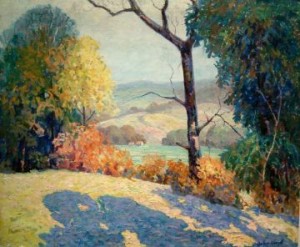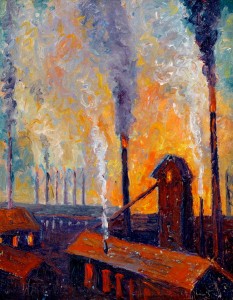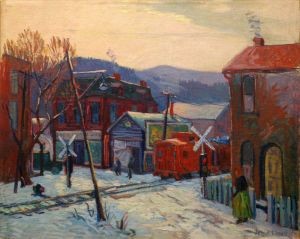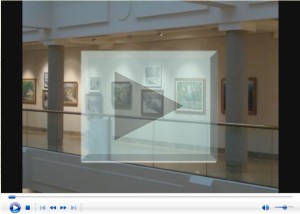Catalog essay by Ms. Margo L. Jacobs, Guest Curator, Butler Exhibit
|
|
The imagery of John L. Lloyd's artistic oeuvre is portraiture, though not in the traditional sense. His work presents to the viewer portraits of a town, an ideal, a culture, and a time in history. Specifically, a time in this country's past when industry was spewing tons of black soot into the air, but life in general was so bucolic that one could not help but see the beauty of the sun shining on a blanket of snow covering the forest ground as heavily as mill dirt covering the town buildings at the very same time. Time and place were central to Lloyd's vision, yet time and place need not be as specific as one day or one city. They were "Anywhere, U.S.A.," as long as it had four beautiful seasons, meandering streams, covered bridges, rolling hills, and a strong industrial presence to support the local economy.
Lloyd was born in 1884 to Charles C. and Susannah Shipton Lloyd in Coaltown, Pennsylvania, a small industrial town approximately sixty miles north of Pittsburgh and sixty miles east of Youngstown, Ohio. By the time of his birth, in the aptly named Coaltown, there were over fifty coke ovens manufacturing coke for the steel industry. Coke production was by far the most dominate industry in the town. The product from this area was strictly destined for two locations: Buffalo, New York and the Mahoning or "Steel Valley" region in Ohio, where Lloyd was soon to move.
In 1898, at the age of fourteen, Lloyd and his family relocated to Warren, Ohio, where he would keep a permanent residence until his death in 1967. Warren and Youngstown were the two major towns comprising the Steel Valley, which was at that time one of the largest steel producing regions in the country.
Because of the lack of records and correspondence, little is known of Lloyd's early childhood years. Photographs from the time indicate that the family lived a comfortable existence, which centered around their traditional Baptist beliefs. They were not rich by any means, but certainly not poor either. Other photographs indicate that Lloyd was an active youth regularly participating in baseball and football. Along with two sisters and another brother, the Lloyds seem to have had a very close-knit household.
Upon closer inspection, a seemingly idyllic upbringing was unfortunately marred by many tragedies. Lloyd's brother Will, at the age of twenty-three, died after sustaining serious injuries during a football game. A mere four years later his sister, Margaret, succumbed to tuberculosis related pneumonia at the age of twenty-nine. In the late 1930s Lloyd's father had to be hospitalized for an unspecified mental illness. Remarkably, given all the sadness that marked Lloyd's life, none of it seems to have come through in his serene imagery.
In 1913 Lloyd enrolled in the Cleveland School of Art, in Cleveland, Ohio, where he successfully completed their decorative design courses. After graduation, Lloyd spent much time traveling to various art colonies and schools. Most notable were his trips in 1915 and 1919 to Woodstock, New York, where he studied painting with the summer classes of the Art Students League. Painter John F. Carlson, then president of the League, was instrumental in relocating the summer classes, which were previously held in Connecticut, to Woodstock. Carlson's influence weighed heavily on Lloyd and his landscapes and winter scenes in particular owe much to Carlson's own painting, as does his impressionistic brushwork and strong sense of modeling.
During his twenties and thirties Lloyd traveled extensively to art colonies throughout the country. While he worked as a meter reader when at home in Warren, Lloyd painted prolifically and it is quite clear painting and art were his first passion. It is also a long-held family assumption that his father financed many of his excursions. It is not clear when or how often Lloyd actually worked for the electric company. He did, however, officially retire from Ohio Edison in 1954 at the age of seventy.
In 1922 Lloyd attended an eight week summer session of art classes at the Pennsylvania Academy of the Fine Arts (PAFA). One of the leading art schools of the day, PAFA held summer classes in Chester Springs, Pennsylvania, a rural colony of artists about thirty miles west of Philadelphia. Founded in 1916 by John F.Lewis, director of the PAFA, the summer program was located at the site of an abandoned orphanage on some forty rural acres of land.
This setting, which appears in many of Lloyd's paintings, is similar geographically to the rolling hills amongst which he grew up in Western Pennsylvania and Northeast Ohio. Some say that the topography of the Chester Springs area lent itself as the ideal location for instruction in landscape painting, and Lloyd's canvases from this period clearly prove that sentiment. Lloyd was a regular visitor to Chester Springs between the years 1919 and 1924.
Because of the strength of his use of color and his mastery of composition, Lloyd was the recipient of many honors and awards. At The Butler Institute of American Art he was awarded both the Gillespie and the Gage prizes. Furthermore, at home in Warren when his schedule allowed, Lloyd taught painting classes at The Butler. Throughout his lifetime, Lloyd's paintings were often exhibited in shows at the Butler and also in many Midyear Retrospectives (annual juried exhibitions at the museum).
 Skilled at depicting the changing seasons, Lloyd's use of light and color was similar to nineteenth-century French impressionism and his sense of place can be described as parallel to his contemporary American Scene painters. His images of rolling hillsides and meandering streams represent "Anywhere, U.S.A.," but they also conjured a sense of nostalgia, a longing for a simpler time and place.
Skilled at depicting the changing seasons, Lloyd's use of light and color was similar to nineteenth-century French impressionism and his sense of place can be described as parallel to his contemporary American Scene painters. His images of rolling hillsides and meandering streams represent "Anywhere, U.S.A.," but they also conjured a sense of nostalgia, a longing for a simpler time and place.
 Juxtaposed to his seasonal landscapes, Lloyd's industrial landscapes do not depict the changing of the seasons, but rather how industry changed the natural landscape. In these paintings, the overbearing machine known as the steel industry is depicted as a place where the seasons pass just as easily as in the rolling hillsides but not nearly as noticeably. Overwhelming gray hues cast shadows on the many buildings in these images while twinges of light from the fiery furnaces radiate behind, regardless of the time of year.
Juxtaposed to his seasonal landscapes, Lloyd's industrial landscapes do not depict the changing of the seasons, but rather how industry changed the natural landscape. In these paintings, the overbearing machine known as the steel industry is depicted as a place where the seasons pass just as easily as in the rolling hillsides but not nearly as noticeably. Overwhelming gray hues cast shadows on the many buildings in these images while twinges of light from the fiery furnaces radiate behind, regardless of the time of year.
In many ways Lloyd's life and career paralleled the rise and fall of the steel industry in the Mahoning Valley and his firsthand knowledge of life in a steel town must have shaped how he viewed the ever-changing landscape on the whole. Much like nature, a steel mill is an ever-changing entity and the sixteen mills located within the Mahoning Valley were in constant evolution throughout Lloyd's lifetime.
 Another theme explored in Lloyd's paintings is the intersection point where industrial landscapes and idyllic rural scenes meet. Although few in number, these townscapes are literally the point where industry and the countryside come together. They are also significant in that they cast a human element into the composition. In these scenes the viewer is reminded of the value of work, for it is in the town where people came to shop and spend their paychecks. The viewer is also reminded of the surrounding landscape by the presence of lush greenery depicted in these images. The last role the town paintings play is to show the viewer the way residents of the surrounding countryside made their way into town and to work. The train station paintings are themselves images depicting intersections, both literally and figuratively.
Another theme explored in Lloyd's paintings is the intersection point where industrial landscapes and idyllic rural scenes meet. Although few in number, these townscapes are literally the point where industry and the countryside come together. They are also significant in that they cast a human element into the composition. In these scenes the viewer is reminded of the value of work, for it is in the town where people came to shop and spend their paychecks. The viewer is also reminded of the surrounding landscape by the presence of lush greenery depicted in these images. The last role the town paintings play is to show the viewer the way residents of the surrounding countryside made their way into town and to work. The train station paintings are themselves images depicting intersections, both literally and figuratively.
During his lifetime Lloyd's work was regularly exhibited throughout the country, at some of the most prestigious venues: the Philadelphia Museum of Art, Columbus Museum of Art, The Butler Institute of American Art, the Art Club of Philadelphia, and at many other sites throughout Cincinnati, Pittsburgh, Toledo, Youngstown, and Warren. Lloyd was a gifted man of many talents, and while his oil paintings are the most highly regarded, he was also an accomplished watercolorist and a great draftsman in pastel. While many of these works are not on a grand scale such as his oil paintings they are nevertheless outstanding in color and composition. Furthermore, he was not just a painter who could depict landscapes and city scenes, but he was also an avid portraitist and still life painter.
A lifelong bachelor, Lloyd passed away in 1967 at the age of eighty-two after creating countless works of art throughout his lifetime. Early in his artistic career John Lloyd was offered a one-man exhibition at The Butler Institute of American Art. Hesitantly, he declined due to the lack of time and resources. Some nine decades later this exhibition is finally being realized.
Margo L.Jacobs
Guest Curator

